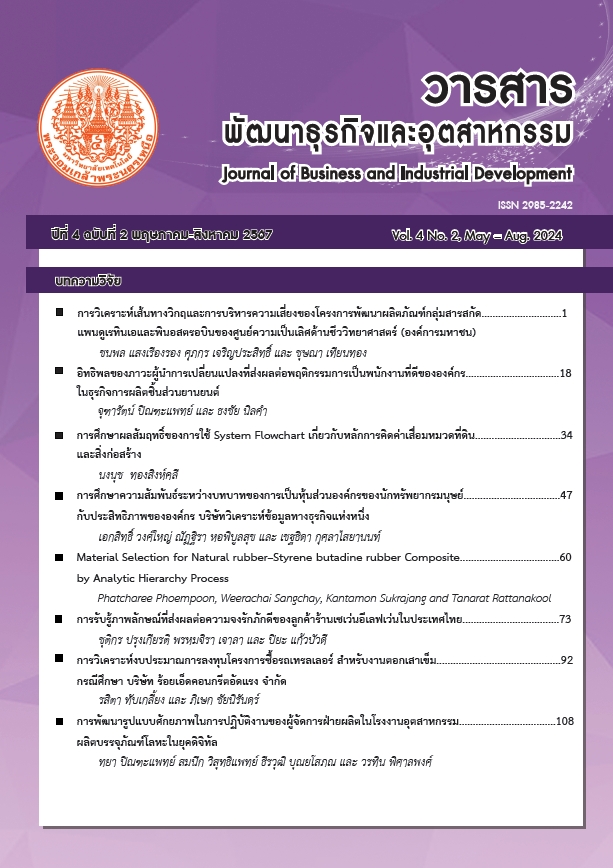Material Selection for Natural rubber–Styrene butadine rubber Composite by Analytic Hierarchy Process
คำสำคัญ:
Natural Rubber, Styrene butadiene rubber, Rubber blend, Analytic Hierarchy Processบทคัดย่อ
Natural Rubber (NR) has distinctive characteristics, namely, it possesses strength, reduces heat accumulation, and performs well at low temperatures, surpassing Styrene Butadiene Rubber (SBR). However, SBR has its own merits, such as resistance to cracking, wet road traction, and better weather resistance than NR. Consequently, in the automotive tire manufacturing industry, NR and SBR are commonly mixed in various ratios. Additionally, this blending aids in cost reduction during production. Thus, this research explores the mixing ratios between NR and SBR at 100/0, 75/25, 50/50, 25/75, and 0/100 using the Analytical Hierarchy Process (AHP) technique as a tool to manage values obtained from tests, including tensile strength, tear resistance, and 300% modulus. All these criteria are amalgamated into a single value to facilitate decision-making in selecting the most suitable ratios. It was found that 100/0 was the most preferable option, followed by 0/100, 75/25, 50/50, and 25/75.
เอกสารอ้างอิง
El-Sabbagh, S. H., Ismail, M. N., & Yehia, A. (2001). Effect of the Curing Systems on Fatigue Behavior of NR Vulcanizates. Journal of Elastomers and Plastics, 33(4), 263–281. https://doi.org/10.1106/6btk-nrf2-140x-lnt2
Hu, J., Liu, W., Yang, L., Lv, H., Zhan, C., & Qiao, P. (2024). Research on Classification Methods for Rubber Based on Terahertz Time-Domain Spectroscopy with Data Fusion Strategy. Infrared Physics & Technology, 105324.
Chang, B. P., Gupta, A., Muthuraj, R., & Mekonnen, T. H. (2021). Bioresource Fillers for Rubber Composite Sustainability: Current Development and Future Opportunities. Green Chemistry, 23(15), 5337–5378. https://doi.org/10.1039/d1gc01115d
Rubber Research Institute, Department of Agriculture
Doma, A. S., & Hassan, H. H. (2017). Curing Parameters and Mechanical Properties of NR/SBR Blends. American Journal of Condensed Matter Physics, 7(4), 87–92. https://doi.org/10.1016/j.cemconres.2019.05.003
Tang, R., & Dong, W. (2020). Effects of Sulfur Curing Systems on Mechanical Properties of NR-SBR Rubber Blends. Polymer Science ChemRxiv, 1–9. https://doi.org/10.26434/chemrxiv.9971285.v4
Tang, R., & Dong, W. (2020). Preparation and Characterization of Modified Natural Rubber Blends for Water Purification Treatment Usage. Polymer Science ChemRxiv, 1–11. https://doi.org/10.26434/chemrxiv.9971285.v13
Ismail, M. N., El-Sabbagh, S. H., & Yehia, A. A. (1999). Fatigue and Mechanical Properties of NR/SBR and NR/NBR Blend Vulcanizates. Journal of Elastomers and Plastics, 31(3), 255–270. https://doi.org/10.1177/009524439903100306
Praveenkumar, S., Sankarasubramanian, G., & Sindhu, S. (2019). Selecting Optimized Mix Proportion of Bagasse Ash Blended High-Performance Concrete Using Analytical Hierarchy Process (AHP). Computers and Concrete, 23(6), 459–470.
Dekic, P. S., Temeljkovski, D. I., Rancic, B., & Nusev, S. (2012). Application of Recycled Rubber Powder (RRP) in NR/SBR Compounds. Journal of Scientific & Industrial Research, 71, 295–298.
Yehia, A. A., Ismail, M. N., Hefny, Y. A., Abdel-Bary, E. M., & Mull, M. A. (2004). Mechano-Chemical Reclamation of Waste Rubber Powder and Its Effect on the Performance of NR and SBR Vulcanizates. Journal of Elastomers and Plastics, 36(2), 109–123. https://doi.org/10.1177/0095244304039896
Dekic, P., Radenkovic, G., Milutinovic, B., & Stefanovic, G. (2017). Environmental, Economic, and Technical Assessment of Rubber Blends with Recycled Rubber. Safety Engineering, 7(1), 33–38.
Saaty, T. L. (2008). Decision-Making with the Analytic Hierarchy Process. International Journal of Services Sciences, 1(1), 83–98.
Umunakwe, R., Oyetunji, A., Adewuyi, B. O., Eze, W. U., Nwigwe, U. S., & Umunakwe, I. J. (2019). Mechanical Properties and Microstructure of Hybrid Vulcanized Natural Rubber Filled with Carbon Black and Nano-CaCO3 From Achatina Achatina Shells. Journal of Metals, Materials and Minerals, 29(4).
Ajinsamajan, A., Rungvichaniwat, A., & Saetung, A. (2022). Utilization of Silicon Dioxide Powder from Industrial Wastes as Novel Filler in Rubber Isolator Application. Journal of Metals, Materials and Minerals, 32(1), 93–100. https://doi.org/10.55713/jmmm.v32i1.1205
Choudhury, I. A., & Hashmi, M. S. J. (2020). Encyclopedia of renewable and sustainable materials. Elsevier.
Stefanović, G., Milutinović, B., Vučićević, B., Denčić-Mihajlov, K., & Turanjanin, V. (2016). A Comparison of the Analytic Hierarchy Process and the Analysis and Synthesis of Parameters Under the Information Deficiency Method for Assessing the Sustainability of Waste Management Scenarios. Journal of Cleaner Production, 130, 155–165. https://doi.org/10.1016/j.jclepro.2015.12.050
Akyüz, S., Darı, M. E., Esiyok, Y. E., & Ermeydan, M. A. (2021). Effects of NR/SBR Ratio on Mechanical Properties and Artificial Mechanical Performance of Anti-Vibration Bushings. Iranian Polymer Journal, 30(12), 1317–1328. https://doi.org/10.1007/s13726-021-00971-4
Bijina, V., Jandas, P. J., Joseph, S., Gopu, J., Abhitha, K., & John, H. (2022). Recent Trends in Industrial and Academic Developments of Green Tyre Technology. Polymer Bulletin, 80(8), 8215–8244. https://doi.org/10.1007/s00289-022-04445-2
Yan, Y., Guo, R., Liu, Z., Yang, Y., & Wang, X.-Y. (2023). Property Improvement of Thermosetting Natural Rubber Asphalt Binder by Mineral Oil. Journal of Materials Research and Technology, 24, 8807–8825. https://doi.org/10.1016/j.jmrt.2023.05.134
Das, S., Satpathi, H., Roopa, S., & Gupta, S. D. (2021). Sustainability of the Tire Industry: Through a Material Approach. In Applied Biopolymer Technology and Bioplastics (pp. 53–98). Apple Academic Press.
Kano, M., Ohtake, Y., Yamanobe, T., & Uehara, H. (2020). Effect of Water Spray on Degradation of Styrene-Butadiene-Rubber During Accelerated Weathering Tests. Polymer Degradation and Stability, 182, 109379. https://doi.org/10.1016/j.polymdegradstab.2020.109379
Burgaz, E., Gencoglu, O., & Goksuzoglu, M. (2019). Carbon Black Reinforced Natural Rubber/Butadiene Rubber and Natural Rubber/Butadiene Rubber/Styrene-Butadiene Rubber Composites: Part I: Rheological, Mechanical and Thermomechanical Properties. Research on Engineering Structures and Materials, 5(3), 233.
ดาวน์โหลด
เผยแพร่แล้ว
รูปแบบการอ้างอิง
ฉบับ
ประเภทบทความ
สัญญาอนุญาต
ลิขสิทธิ์ (c) 2024 วารสารพัฒนาธุรกิจและอุตสาหกรรม

อนุญาตภายใต้เงื่อนไข Creative Commons Attribution-NonCommercial-NoDerivatives 4.0 International License.





